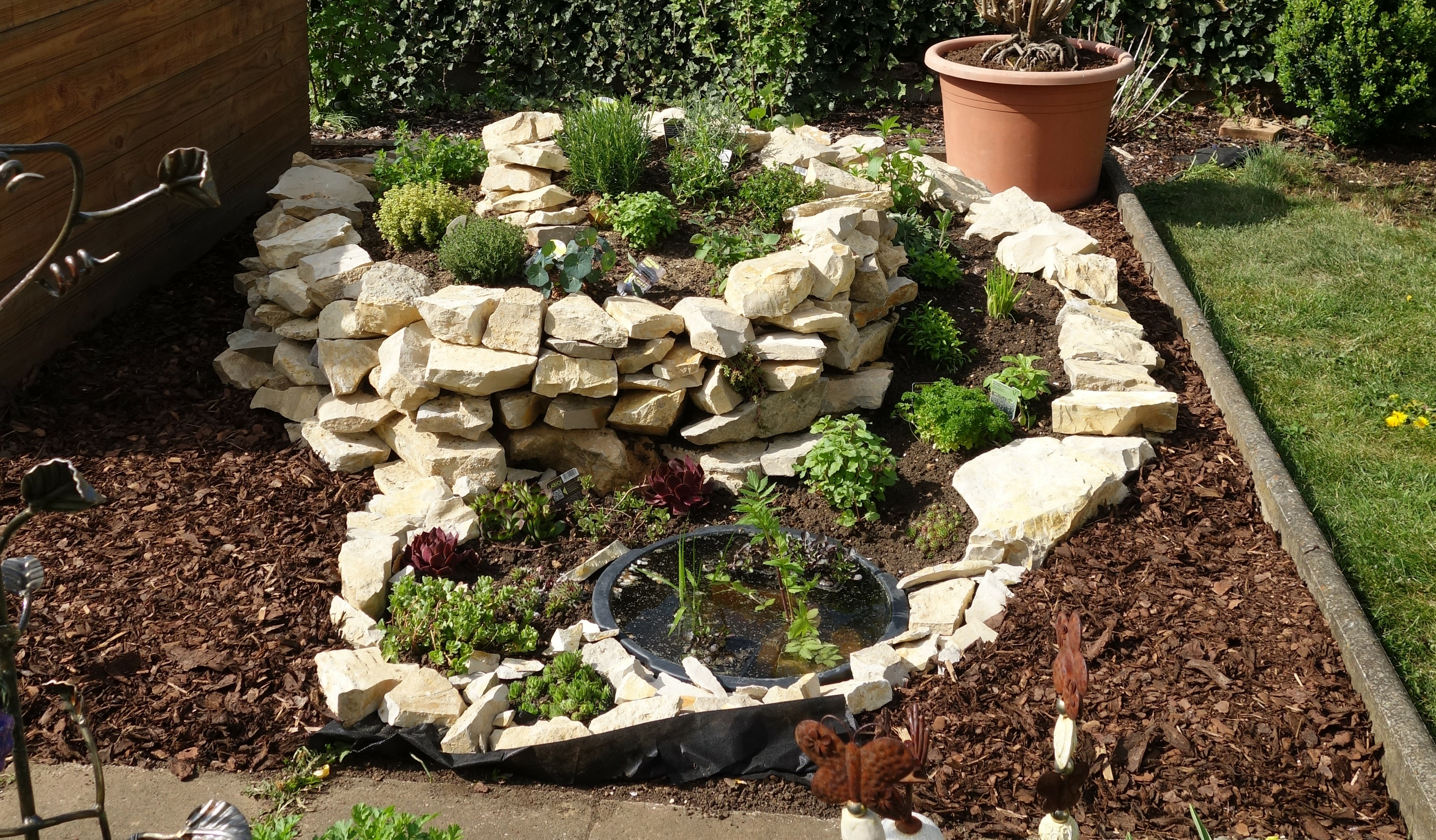
How to Build and Plant a Herb Spiral: Layout and Planting Plan
Every herb lover would love to have a herb spiral or herb snail in their own garden. They can accommodate a wide variety of herbs in a small space, which you can use in the kitchen as spices or medicinal plants. A herb spiral also looks great in the garden. In this article, you will learn how to create and plant your own herb spiral.
This Article Contains:
- Building a Herb Snail Pays Off
- Creating a Herb Spiral: The Right Location
- Herb Spiral: Instructions
- Which Soil for Herbs?
- The Best Time: When to Plant Herbs?
- Planting the Herb Snail: 4 Zone Plan
- Mixed culture planting plan: ideas for your herb snail
- Table: Which herbs go together? (PDF)
- Frequently Asked Questions About the Herb Spiral
Quick Overview
Herb Spiral: Building Instructions
- Habitat: full sun and warm
- Dimensions: highest point at 31.5 inches, diameter 2.2 to 3.3 yards
- Material: fist-thick stones, gravel, crushed stone, compost, sand, humus-rich soil, pond liner
- Mark the ground plan
- Dig up topsoil to spade depth and lay turf upside down on top
- Lay a gravel foundation
- Build a retaining wall
- Fill with coarse gravel (15.7 inches high layer in the middle, thinning out towards the outside)
- Fill with soil (note the differences in zones!)
- Alternatively: create a pond
- Sit back and wait, after 5 to 10 days you can plant your herb spiral
Building a Herb Snail Pays Off
A herb snail differs from a classic herb bed mainly in its design. Thanks to its snail-like structure, in which different soil and site conditions can be created in stages, a wide variety of herbs find the ideal conditions to grow and thrive. Mediterranean, sun-loving herbs can be planted at the very top, in the middle of the spiral. The spiral slopes downwards towards the outside until it reaches the ground. This creates different moisture zones within the spiral, which are supplemented with different substrates. In this way, a spot can be created for Mediterranean as well as native and water-loving herbs.
Creating a Herb Spiral: The Right Location
A herb spiral provides a place for a wide variety of herbs that would not normally grow in the same location. Mediterranean sun worshippers such as rosemary, lavender or thyme like it warm and sunny and want to face south. The highest part should therefore face south and the lowest part north. This is because this is where herbs are planted that like to have wet feet and also like to be in partial shade. In general, however, most herbs prefer a sheltered, full-sun location and plenty of warmth.
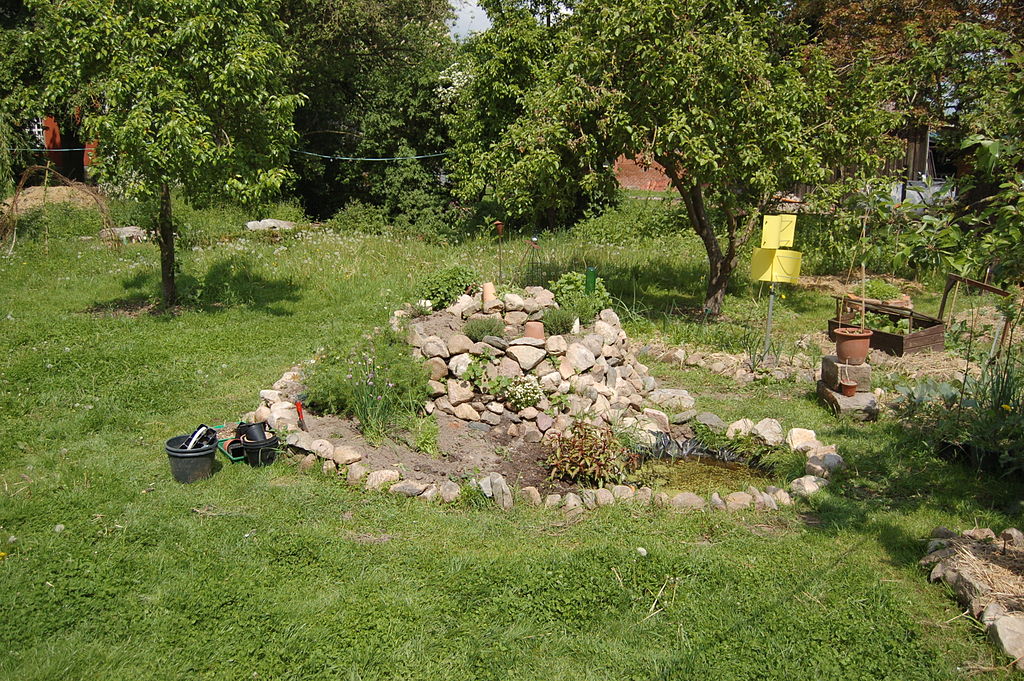
Can You Build a Herb Spiral on the Balcony?
Herb snails require a lot of space and a sunny location facing south. Therefore, not every balcony is suitable. If both of these apply to you, you can start planning, although you must take the load-bearing capacity of your balcony into account. Lighter materials such as wood are better suited as building materials.
Herb Spiral: Instructions
Material:
- Bricks or natural stones that are at least as thick as a fist
- Gravel and crushed stone
- Compost, humus-rich soil and sand
- Alternatively: pond liner or bucket
Step-By-Step Instructions:
- Find a suitable spot as described above and mark the outline of your herb spiral on the ground; it should have two turns. The best way to do this is to use stakes with a string between them.
- Now dig up the topsoil within the boundaries to the depth of a spade and lay the turf on the ground around it.
- Now cover the base area with gravel or rubble to create a foundation as a stable base for the wall. This gravel foundation also acts as a drainage system, preventing waterlogging. Next, build the spiral retaining wall. To do this, simply stack the bricks or natural stones on top of each other. Start with the first row of stones to create the complete shape of the spiral. The retaining wall gets higher and higher from the outside to the inside, reaching its highest point in the middle at around 31,5 in. Garden animals such as lizards or slow worms will find a home in the gaps and plants will also settle there over time. You can also sow strawberries, dost or thyme in the gaps right from the start and once your basic structure is stable, fill it with coarse gravel or crushed stone. You can place a 15,7 in thick layer in the middle, which becomes thinner and thinner towards the outside and finally runs out with the pond
- Then fill in the soil. Do not use standard soil for this, as the aim is to create different areas. You can find out exactly how to fill your herb snail with soil and what you need to bear in mind further down in this article.
- Once your herb snail has been set up and filled, the work is done and you can sit back and relax. Give the soil some time to settle. After a few rain showers (if it's too dry, you should water every now and then) you can see whether you need to add more soil or not.
- After 5 - 10 days you can plant your herb spiral.
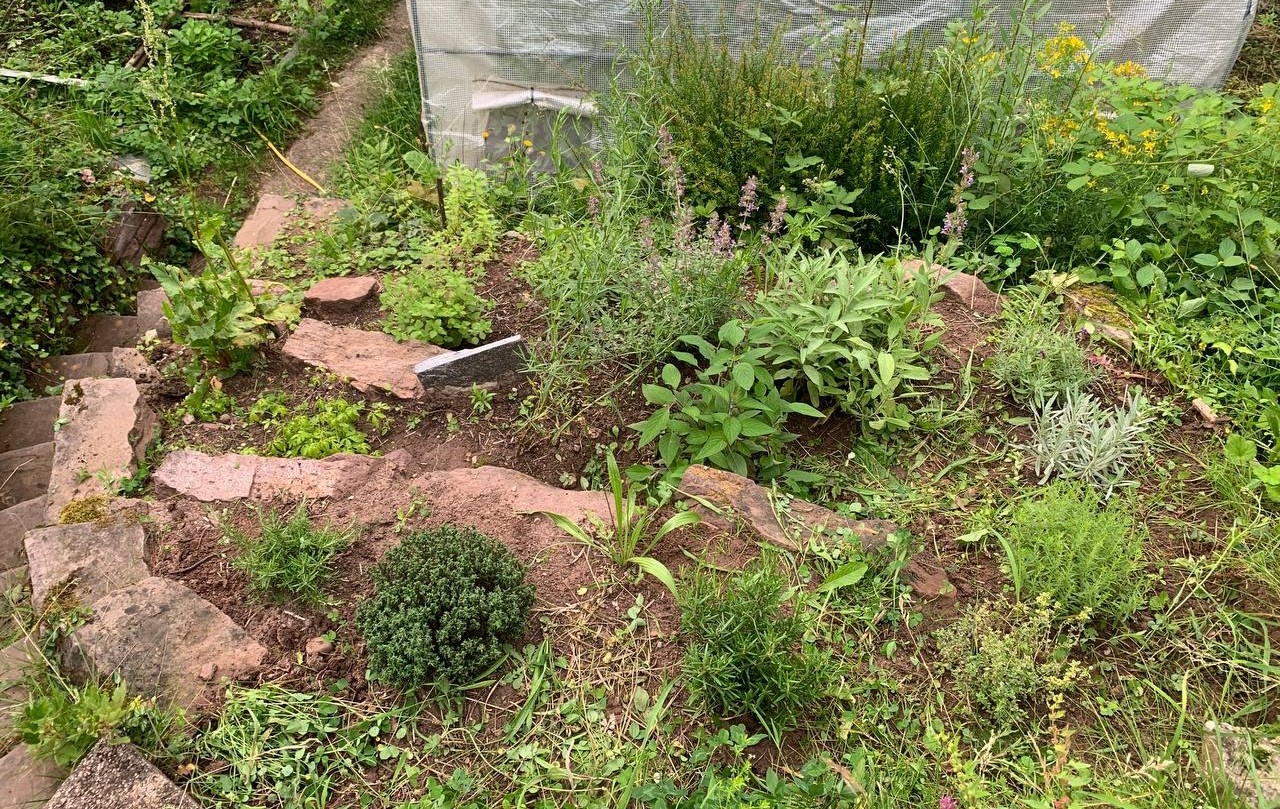
Which Soil for Herbs?
To ensure that all herbs feel at home, you should adjust the soil in the different zones accordingly. The proportion of humus and sand is particularly important, as this allows you to regulate the water and nutrient balance of the soil. It is therefore essential that you know what your herbs need in order to plant them in the right place later on. How to mix the soil in the zones is explained below:
- For the uppermost zone (Mediterranean zone), mix half of the garden soil with sand and, if your garden soil is particularly clayey, with gravel. The proportion of sand gradually decreases towards the bottom, which is the transition to the temperate zone of the herb snail
- In the middle area (temperate zone), the garden soil is enriched with compost and humus-rich soil, with the proportion increasing towards the bottom
- The spiral ends with the moist zone. Here the mixture consists only of humus soil and compost
The Best Time: When to Plant Herbs?
Spring is the best time to plant your herb spiral, so the herbs have the whole summer to grow well before the cold winter arrives. In addition, some herbs are only hardy to a limited extent and need to be covered in winter or will retreat into the ground. If you still want to plant in the fall, you should only replant these herbs in the spring. For planting, it is best to get pre-grown young plants of organic quality from the market or similar. This is because many herbs take a long time to grow, especially the warmth-loving herbs.
Planting the Herb Snail: 4 Zone Plan
A herb spiral can be divided into four zones and should be planted accordingly. When selecting plants for your herb spiral, you should pay attention to the plants' needs in terms of location and soil, as well as which compaion plants they harmonize particularly well with.
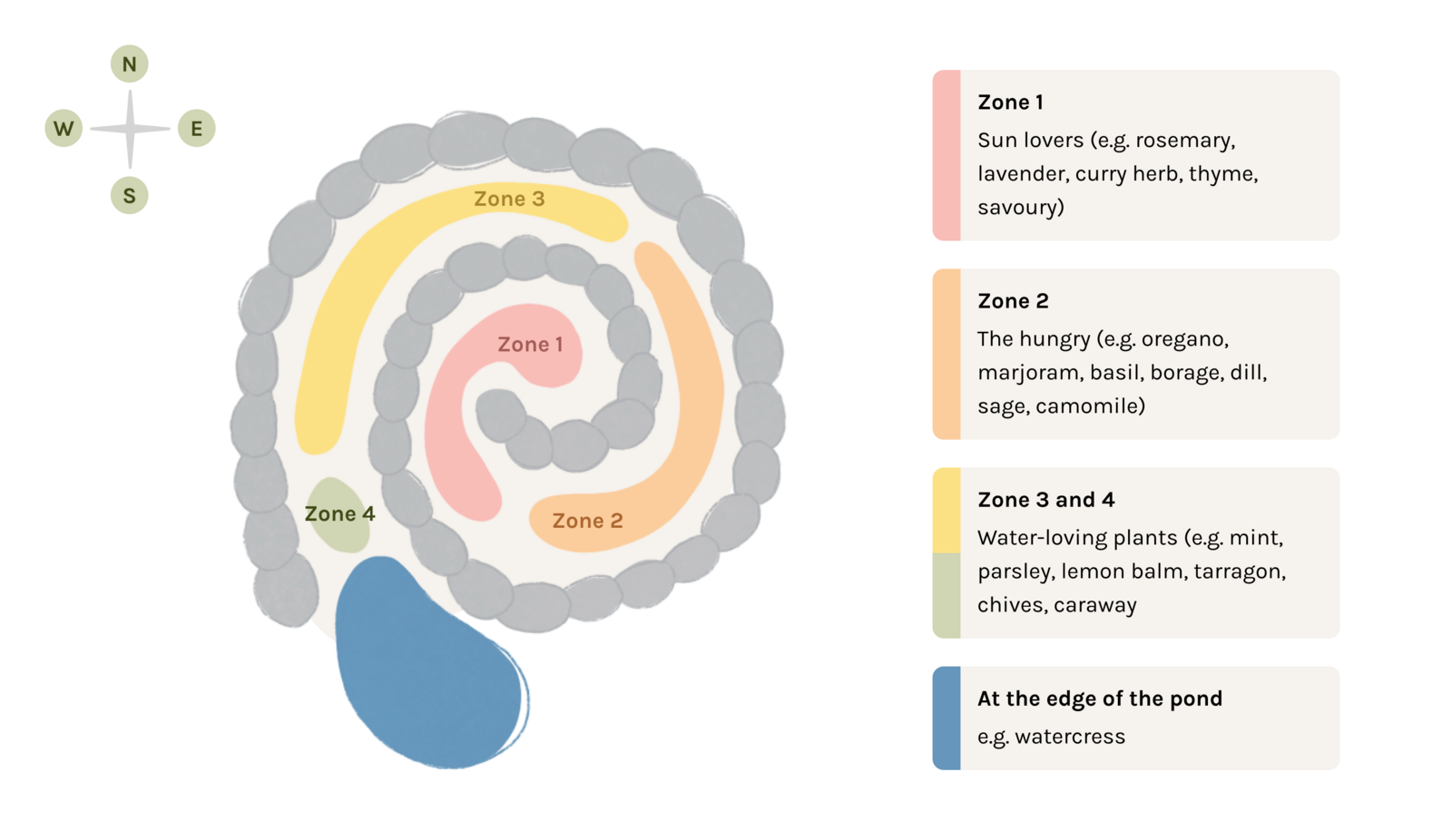
Our tip: However, there are also exceptions that should not be planted in the herb snail. Herbs such as lovage (Levisticum officinale) and comfrey (Symphytum) are loners, as they inhibit the growth of other herbs through root substances and strong root growth.
Herb Spiral With Pond
A small pond can be created at the base of the spiral. You can use a bucket for this or dig a hole about 15,7 inches deep and line it with pond liner. Pour a thin layer of sand into the hole before and after so that the liner sits better. You can place large stones on the edge of the liner to secure it. This creates a humid microclimate that attracts insects and provides moisture on hot days. Unfortunately, a mini pond is not suitable for growing edible aquatic plants as it would need to be larger. However, watercress (Nasturtium officinale) feels very much at home in the soil of the predominantly moist pond edge.
Zone 1: Mediterranean Herbs
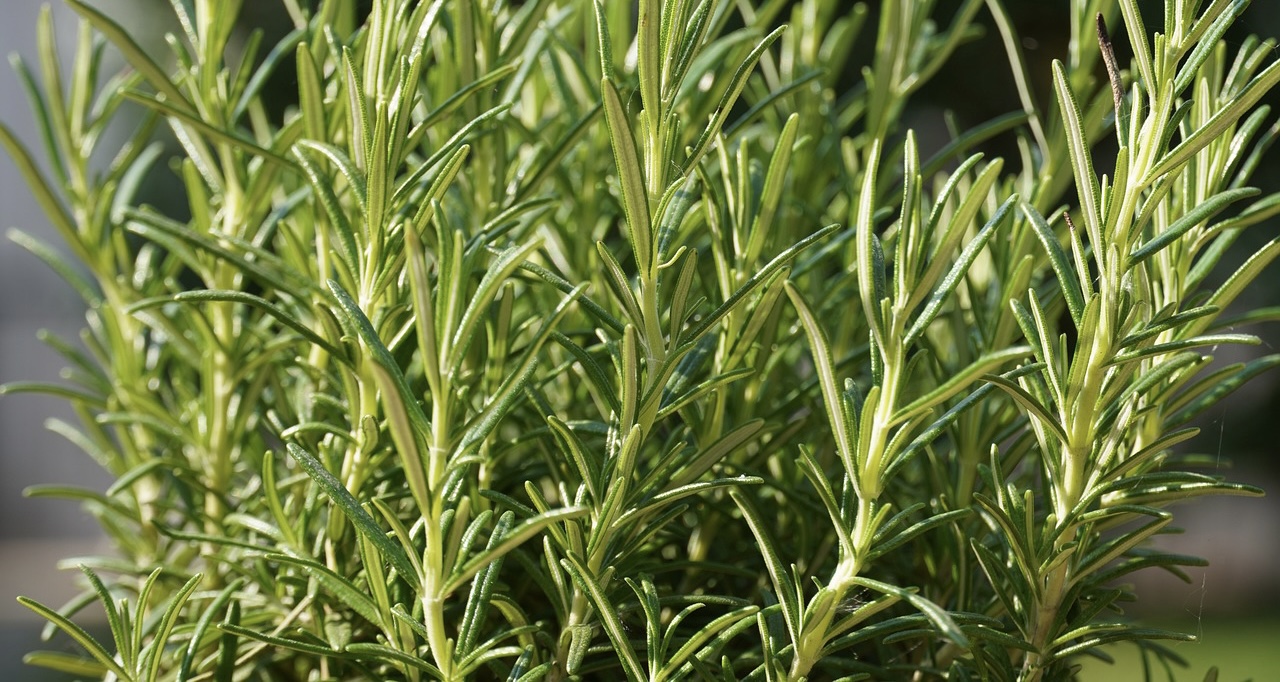
The uppermost area is the Mediterranean zone . Warmth-loving plants that prefer to grow in well-drained, poor, light soil find a place here.
Table of Mediterranean Herbs: Planting Distance & Companion Plants
| Planting Distance | Good Companion Plants | Bad Companion Plants | |
|---|---|---|---|
| Savory | 7,8 x 9,8 in | Oregano, sage, thyme | Basil, lovage, mint |
| Italian Strawflower | 11,8 x 11,8 in | Savory, lavender, sage, thyme, tarragon | |
| Lavender | 15,7 x 11,8 in | Lemon balm, thyme, sage, curry herb, oregano, hyssop, rosemary | Parsley |
| Rosemary | 9,8 x 9,8 in | Oregano, sage, thyme, lavender, basil | Lovage, chives |
| Thymie | 9,8 x 11,8 in | Savory, tarragon, lemon balm, rosemary, sage, chives, hyssop, lavender | Basil, dill, lovage, marjoram, mint |
Zone 2: The Hungry Herbs
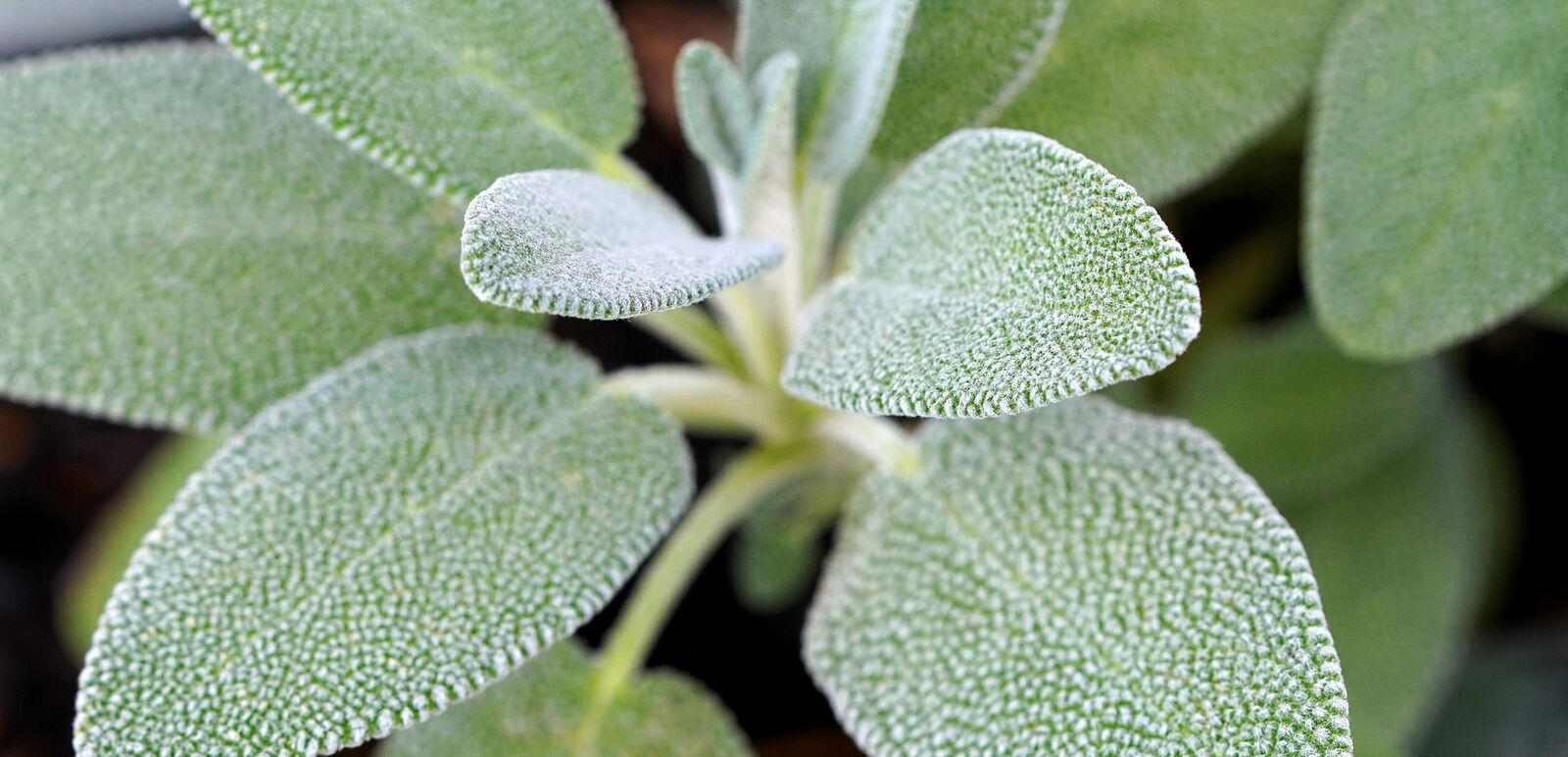
In the middle you will find the temperate zone, which ties in with the Mediterranean area. Here you can plant herbs that tend to thrive in medium-heavy soil and the soil can be somewhat richer. This zone faces both south and north. Herbs that prefer partial shade can be planted further down and sun-loving plants further up.
Mixed Crop Table: Distance & Good Companion Plants
| Planting Distance | Good Companion Plants | Bad Companion Plants | |
|---|---|---|---|
| Basil | 5,9 x 7,9 in | Fennel, oregano, parsley, rosemary | Savory, lovage, marjoram, lemon balm, mint, sage, thyme |
| Borage | 9,8 x 11,8 in | Savory, dill, tarragon, caraway, marjoram | Lovage, parsley |
| Dill | 5,9 x 9,8 in | Borage, chervil, marjoram, parsley, chives | Tarragon, fennel, caraway, lovage, sage, thyme |
| Camomile | 5,9 x 3,9 in | Chives | Lovage, mint |
| Marjoram | 5,9 x 3,9 in | Borage, dill, chervil, parsley | Basil, fennel, lovage, oregano, thyme |
| Oregano | 5,9 x 9,8 in | Basil, savoury, rosemary, sage, chives, lavender | Lovage, marjoram |
| Sage | 11,8 x 11,8 in | Savory, fennel, lemon balm, oregano, rosemary, thyme, lavender | Basil, dill, lovage |
Zone 3 & 4: Water-Loving Herbs
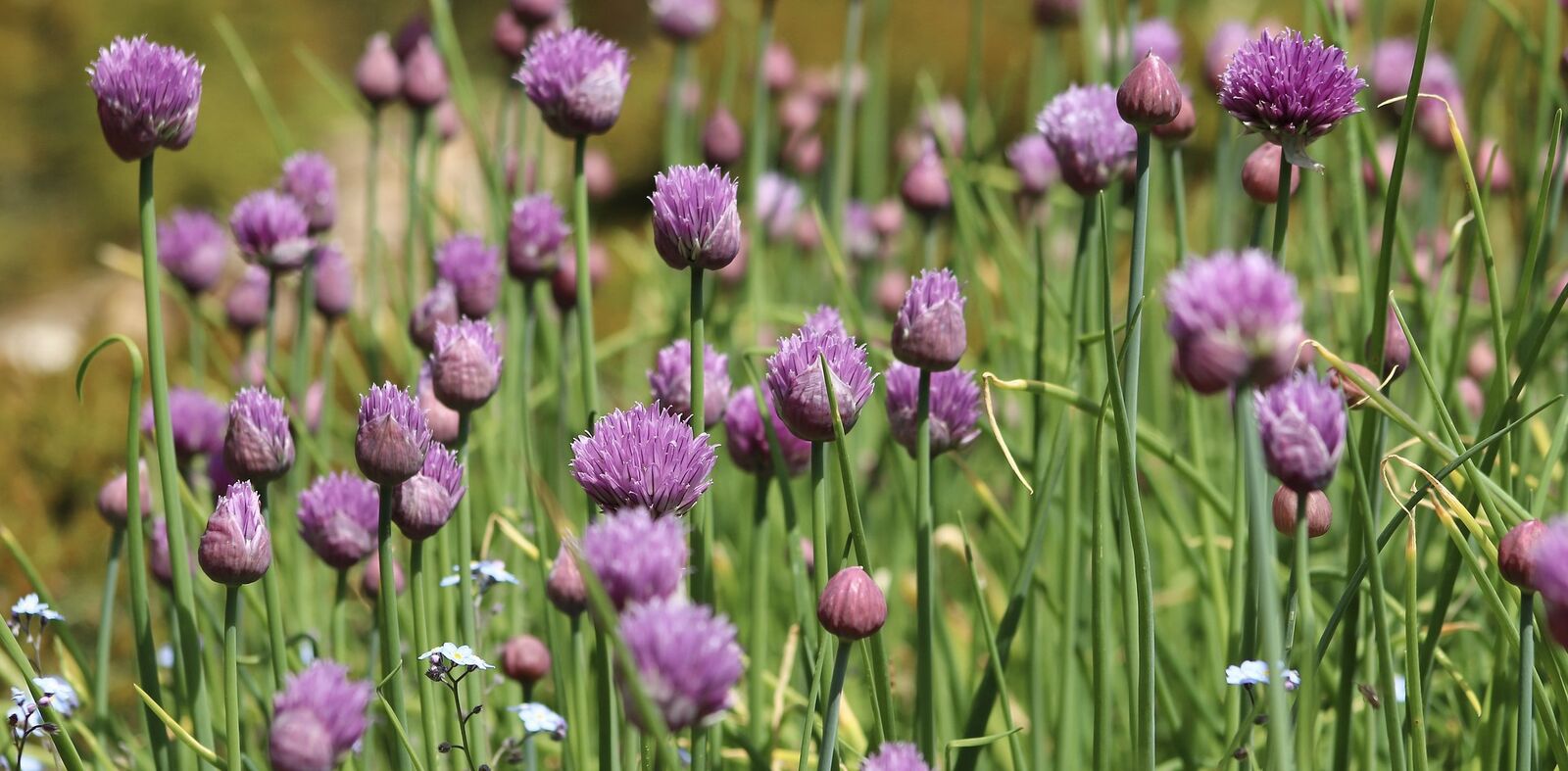
In the last and lowest zone, the moist zone , the soil should be heavy, moist and humus-rich. A high compost content is important here, as this increases the water storage capacity and nutrient content.
Table: Which Herbs to Plant Together?
| Planting Distance | Good Companion Plants | Bad Companion Plants | |
|---|---|---|---|
| Tarragon | 5,9 x 3,9 in | Borage, lovage, thyme | Dill |
| Caraway | 7,9 x 9,8 in | Borage, parsley | Dill, fennel, lovage |
| Mint | 9,8 x 9,8 in | Lemon balm | Basil, savoury, camomile, lovage, parsley, thyme |
| Lemon balm | 9,8 x 9,8 in | Mint, sage, chives, thyme, lavender | Basil, lovage |
| Parsley | 9,8 x 3,9 in | Basil, savoury, camomile, caraway, marjoram, thyme | Chervil, lovage, mint, lavender, dill |
| Chives | 0,8 x 9,8 in | Dill, camomile, lemon balm, oregano, thyme | Coriander, lovage, rosemary |
Mixed culture planting plan: ideas for your herb snail
We have prepared digital planting plans as inspiration for your herb spiral: from a small herb spiral for the balcony to a colourful large spiral with herbs and cut vegetables.
Hopefully you now have everything you need to build and plant your own herb spiral. If you already have an herb spiral in your own garden or would like to create one, we would be delighted if you would share it with us in the community. If you have any questions or suggestions, please email us at magazin@fryd.app.
Not yet part of the Fryd community?
Then register here or download the free Fryd app for Android or iOS. Here you can exchange ideas with others about gardening and get help with questions or problems.
Fryd - your digital bed planner
Cover picture by Johann56 on wikimedia commons.
Marie
Current Topics in the Community

#red , #tuesday

Liked 1 times
#testpostcount

Dec 2025
Popular Articles

Companion Plants for Carrots: What (Not) to Plant With Carrots

Companion Plants for Celery : What (Not) to Plant With Celery?

Strawberry Types: List of Best Strawberry Varieties

Companion Planting With Strawberries: Companion Plants and Planting Plan

Basil Varieties & Types at a Glance

What to Plant With Cabbage: Good and Bad Companion Plants

Fertilizing Strawberries: Home Remedies & Natural Fertilizers at a Glance

Growing Sweet Potatoes: Tips on Cultivation & Companion Plants

Companion Plants for Kitchen Herbs: Chives, Parsley & Co

What Herbs Can Be Planted Together?
FAQ
Where is the best location for a herb snail?
The location should be full sun and sheltered. The highest point should face south and the lowest point north. A balcony is only suitable for a herb snail if it has the necessary load-bearing capacity.
You can choose freely from all the herbs you like. There is a suitable place for every herb in a herb spiral. When planning, you should only pay attention to location requirements (soil, water and light) and good neighbors.
A herb snail provides optimum growing conditions for various herbs by creating different microclimate zones and enabling good drainage. This allows plants to be cultivated effectively and in a space-saving manner.
Which herbs can I not plant in a herb spiral?
You should not plant invasive herbs such as mint in a herb spiral, at least not without a root barrier. Lovage is also a loner because it inhibits the growth of its neighbors.